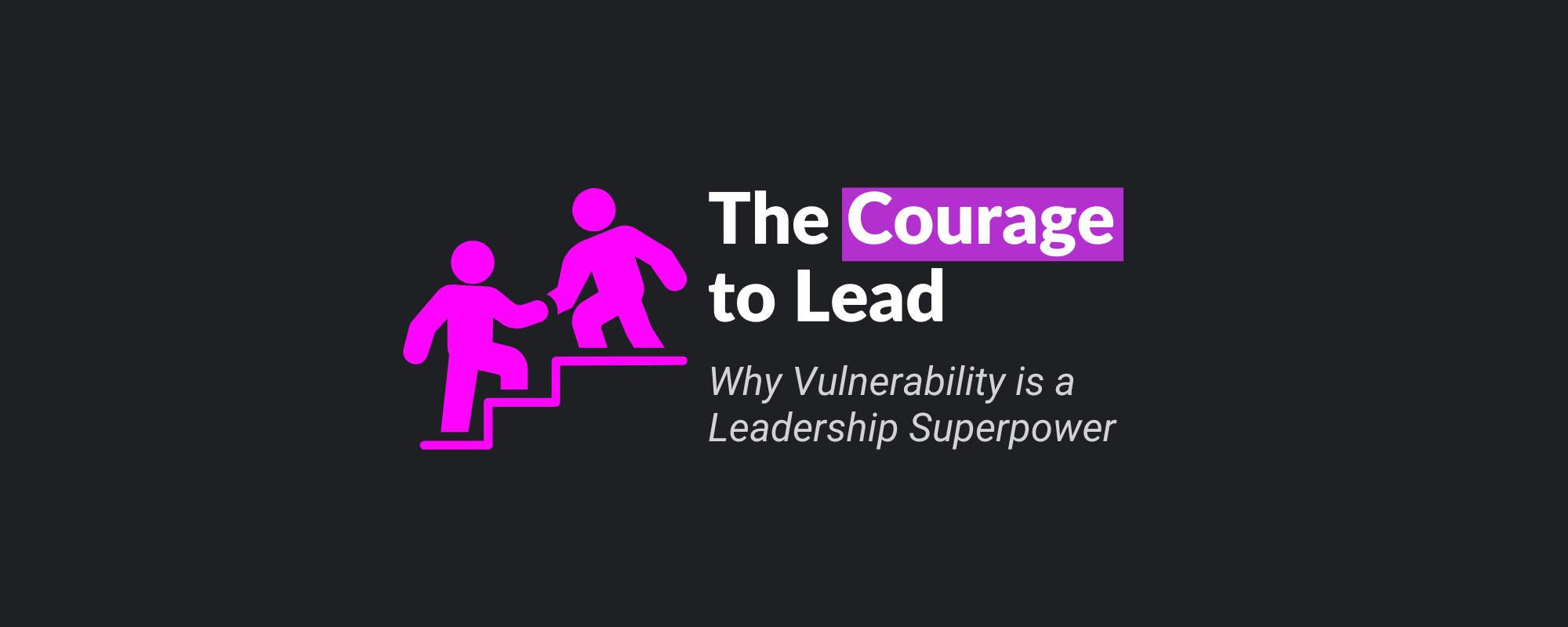The Courage to Lead

Vulnerability in leadership is a paradox: it requires courage but unlocks strength. It isn't about being weak or overly emotional; it’s about being real, relatable, and authentic. It's about connecting on a human level and building trust by showing that you, too, are navigating challenges. This authenticity becomes a key ingredient in cultivating a culture where people feel valued beyond their job titles. Vulnerability breaks down barriers and fosters genuine human connections, which is the essence of effective leadership.
Imagine a leader who walks into a room and openly admits, "I don't have all the answers, but together, we can figure this out." This approach was used effectively by Satya Nadella during his early days as Microsoft's CEO. He openly acknowledged the company's need for cultural change and sought collaboration, ultimately reinvigorating the organization. That kind of honesty has the power to unite a team, replacing fear with collaboration and uncertainty with possibility. It’s an antidote to the outdated model of the all-knowing, unflappable leader. Vulnerability, at its core, is about showing people who you really are—because that’s what inspires them to bring their best selves to work too.
What Vulnerability in Leadership Really Means
True vulnerability is the courage to be seen as you are—without all the layers of pretense. It’s not about incompetence or being overly emotional, and it certainly isn't about exposing every insecurity. Instead, it’s about authenticity. It’s about being comfortable enough to show that you, too, face challenges and are willing to grow from them.
For years, leadership was painted as a tough facade, a veneer of invulnerability. Leaders were meant to be unbreakable, impenetrable, and beyond reproach. But how can anyone connect with that? We, as human beings, connect through shared experiences and shared struggles. When leaders drop the armor and show that they are human—fallible and yet determined—it inspires teams to do the same.
Let’s be clear: vulnerability isn’t the same as weakness. In fact, it requires more strength to admit you’re not perfect than to pretend that you are. Vulnerable leaders are those who admit when they need help, acknowledge their mistakes, and accept constructive criticism. They have the guts to say, “I don’t know, but let’s find out together.” It’s the type of leadership that doesn’t just command but invites people to join the journey.
The Impact of Vulnerability on Teams
Teams thrive under leaders who foster an environment of trust and openness. When a leader shows vulnerability, it gives the team permission to do the same. This cultivates psychological safety, an environment where individuals feel they can take risks without fear of ridicule or retribution. Google’s Project Aristotle, for instance, found that psychological safety was the number one predictor of high-performing teams.
In Middle Eastern cultures, there is a complex balance between authority and empathy. Traditional leadership emphasizes strength and decisiveness, admirable qualities that can sometimes prevent genuine connection. Despite the perception that vulnerability is avoided in leadership within the Middle East, it can be incredibly transformative, significantly enhancing team morale, productivity, and efficiency. The emerging wave of leaders in the UAE and KSA are redefining this balance, showing that empathy enhances rather than detracts from authority. In my years working in the UAE and KSA, I've found that vulnerability must be paired with deep respect for the team. Sharing personal struggles or admitting a mistake is most effective when the team knows you’re fully committed to their growth. I often frame admissions of error as opportunities for all of us to improve—a collaborative journey rather than a directive. Leaders here are demonstrating that strength and humanity can indeed coexist.
Creating Space for Vulnerability
So how do you actually create space for vulnerability? It starts with something deceptively simple: listening. Not just listening to respond, but genuinely listening to understand. When leaders make time to truly hear their teams—when they ask questions like, “What do you need from me?” or “How can I support you?”—they open the door to meaningful conversations.
Another way to create space for vulnerability is by sharing your own stories—both successes and failures. From my own experience, early in my career, I faced a project that went completely off track. Instead of hiding the setbacks, I openly discussed the issues with my team and acknowledged where I had made a wrong call. To my surprise, this openness rallied the team together. We worked more collaboratively, and their trust in me grew as they saw I wasn't afraid to admit my missteps. That moment showed me firsthand the power of vulnerability—it's not about admitting defeat; it's about empowering your team to face challenges head-on, knowing their leader is also learning. There’s nothing quite as disarming as a leader who admits, “I once made this mistake, and here’s what I learned from it.” It shows that it’s okay to stumble, as long as you get back up and learn something along the way.
Psychological safety is a key foundation for creating space for vulnerability. It’s about making sure your team knows that mistakes aren’t the end—they are part of the process. When team members feel safe to express concerns, admit errors, and voice their ideas without fear, creativity blossoms. Vulnerable leaders set the tone by showing that they, too, are learning, evolving, and occasionally failing.
The ROI of Vulnerability
What’s the return on investing in vulnerability? The results speak for themselves. Gallup’s research indicates that managers who display vulnerability report higher employee engagement. When leaders admit their own limitations, it humanizes them, making it easier for team members to connect with them on a personal level.
Employees who feel they can trust their leader are more engaged and motivated. Vulnerability drives trust, which in turn drives loyalty. It’s a powerful cycle. A Harvard Business Review survey showed that employees feel more motivated when their leaders admit mistakes because it creates an environment where they feel seen and valued.
Avoiding the Oversharing Trap
Of course, there’s a line between vulnerability and oversharing. Vulnerability should serve the team—it’s about admitting what’s real to foster growth without creating unnecessary burdens. One of the best pieces of advice I've ever given a fellow leader was to 'choose vulnerability with purpose.' During a project crisis, I shared a mistake from the past that was relevant, and it brought clarity and reassurance to my team. By focusing on a specific, purposeful instance, I fostered a stronger sense of trust and cohesion. I avoided any unrelated struggles because vulnerability should empower, not create anxiety. I always think, ‘How will sharing this help my team?’—if the answer isn't clear, I hold back. Leaders need to strike a balance. Sharing too much can make you seem unstable or create unnecessary anxiety among the team. Vulnerability in leadership isn’t about emotional dumping; it’s about sharing enough to let others know you’re human, without overwhelming them.
Think of it as sharing the right story at the right time. If your team is facing a particularly challenging project, sharing a story about a time you faced similar adversity—and overcame it—can be empowering. But telling them about a personal crisis without context or a relevant point? That can backfire, leading to discomfort or unease. Vulnerability should be about service, not self-indulgence.
Strength in Authenticity
Ultimately, vulnerability is about having the courage to show up as your true self—without masks or pretense. For example, when I was leading a new team during a high-stakes project, I admitted my uncertainties about our approach. This honesty encouraged the team to speak up, and one member suggested an idea that became pivotal to our success. This act of openness didn’t just make me relatable; it allowed us to find the best solution together. It’s about trusting that your real self is enough, that your humanity is what makes you a great leader. And it’s not just a nice-to-have quality in leadership—it’s essential. A leader who can say, “I was wrong,” or “I need your help,” invites others to contribute, to feel valued, and to rise to their potential.
True strength isn't about never failing; it's about rising each time you do. It's about standing in front of your team, admitting you don't have all the answers, and saying, 'We will find a way together.' That’s the kind of leadership that people remember. That’s the kind of leadership that changes companies—and changes lives.
So, as you lead, consider this: Are you willing to be seen for who you truly are? Are you ready to let your guard down just enough to let others in? The reward is more than an engaged team—it’s the satisfaction of knowing you're leading in a way that is genuine, impactful, and deeply human.


Discussion